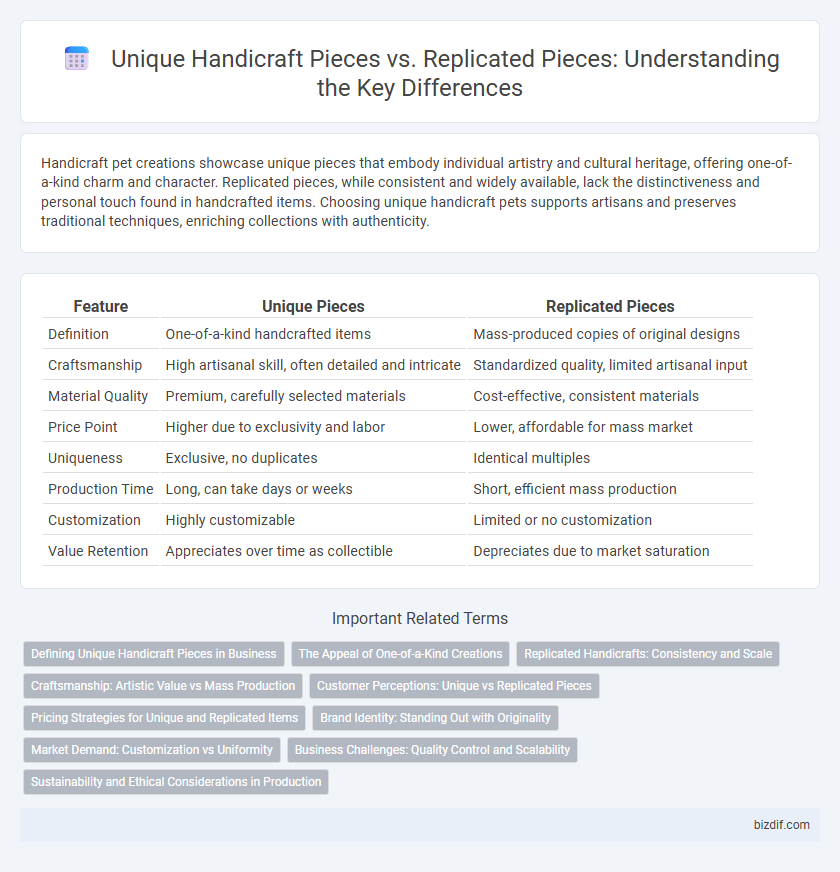Handicraft pet creations showcase unique pieces that embody individual artistry and cultural heritage, offering one-of-a-kind charm and character. Replicated pieces, while consistent and widely available, lack the distinctiveness and personal touch found in handcrafted items. Choosing unique handicraft pets supports artisans and preserves traditional techniques, enriching collections with authenticity.
Table of Comparison
| Feature | Unique Pieces | Replicated Pieces |
|---|---|---|
| Definition | One-of-a-kind handcrafted items | Mass-produced copies of original designs |
| Craftsmanship | High artisanal skill, often detailed and intricate | Standardized quality, limited artisanal input |
| Material Quality | Premium, carefully selected materials | Cost-effective, consistent materials |
| Price Point | Higher due to exclusivity and labor | Lower, affordable for mass market |
| Uniqueness | Exclusive, no duplicates | Identical multiples |
| Production Time | Long, can take days or weeks | Short, efficient mass production |
| Customization | Highly customizable | Limited or no customization |
| Value Retention | Appreciates over time as collectible | Depreciates due to market saturation |
Defining Unique Handicraft Pieces in Business
Unique handicraft pieces are defined by their one-of-a-kind design, handcrafted techniques, and use of authentic, often locally sourced materials that reflect cultural heritage and artisan skill. These items carry intrinsic value through their individuality, limited availability, and the personal story of the maker, distinguishing them from mass-produced replicated pieces. In business, emphasizing uniqueness enhances brand identity, attracts niche markets willing to pay premium prices, and supports sustainable craftsmanship.
The Appeal of One-of-a-Kind Creations
Unique handicraft pieces captivate collectors and enthusiasts by embodying individuality and artistic expression unavailable in replicated items. The appeal of one-of-a-kind creations lies in their distinctiveness, as each item tells its own story through handcrafted details and unique materials, enhancing emotional value and cultural significance. Unlike mass-produced replicas, these exclusive crafts offer originality and authenticity that reflect the artisan's skill and heritage, making them treasured additions to any collection.
Replicated Handicrafts: Consistency and Scale
Replicated handicrafts provide consistent quality and design precision by utilizing standardized techniques and molds, ensuring uniformity across multiple items. This scalability allows artisans and manufacturers to meet higher demand without compromising the visual and structural integrity of their products. Consequently, replicated pieces are ideal for markets requiring bulk orders, while maintaining the essence of traditional craftsmanship.
Craftsmanship: Artistic Value vs Mass Production
Handicraft emphasizes unique pieces that showcase meticulous craftsmanship and artistic value, reflecting the artisan's skill and cultural heritage. Each handcrafted item embodies individuality and originality, contrasting with replicated pieces produced through mass production methods that prioritize uniformity and volume over artistic expression. The intrinsic value of unique handcrafted objects lies in their distinctiveness, often perceived as authentic works of art rather than mere commodities.
Customer Perceptions: Unique vs Replicated Pieces
Customers often perceive unique handicraft pieces as more valuable due to their originality, craftsmanship, and exclusivity, fostering emotional connections that mass-replicated items lack. Replicated pieces, while more affordable and consistent in quality, may be seen as less authentic and less capable of conveying personal or cultural significance. Buyer preferences tend to favor unique items when seeking meaningful, one-of-a-kind decor or gifts, whereas replicated pieces appeal to those prioritizing cost and uniformity.
Pricing Strategies for Unique and Replicated Items
Pricing strategies for unique handicraft pieces often emphasize their exclusivity, craftsmanship, and limited availability, allowing artisans to command premium prices. Replicated handicraft items are typically priced more affordably due to mass production, reduced labor costs, and standardized designs that appeal to broader markets. Balancing scarcity and accessibility helps artisans optimize revenue while catering to diverse customer preferences.
Brand Identity: Standing Out with Originality
Handicraft brands emphasize the uniqueness of original pieces to enhance brand identity, distinguishing themselves from competitors who offer replicated products. Unique handcrafted items showcase individual artisanship, fostering a deeper emotional connection with customers seeking one-of-a-kind creations. This originality drives brand loyalty and positions the business as a leader in authentic, bespoke craftsmanship.
Market Demand: Customization vs Uniformity
Unique handcrafted pieces attract a growing market segment seeking personalized, one-of-a-kind items that reflect individual taste and cultural significance. In contrast, replicated handicrafts appeal to consumers valuing affordability and consistency, often driving higher volume sales in mass markets. Market demand increasingly favors customization, with artisans leveraging bespoke techniques to meet niche preferences and differentiate their offerings from uniform manufactured goods.
Business Challenges: Quality Control and Scalability
Unique handcrafted pieces demand rigorous quality control to maintain their distinctiveness and artisan value, often limiting scalability due to time-intensive production processes. Replicated pieces, while easier to scale through standardized methods, face challenges in preserving craftsmanship quality and market appeal. Balancing quality assurance with production efficiency remains a critical business challenge for artisans and companies in the handicraft industry.
Sustainability and Ethical Considerations in Production
Unique handicraft pieces showcase sustainable artistry by minimizing mass production waste and preserving traditional techniques that honor cultural heritage. Replicated pieces often rely on mechanized processes that can deplete natural resources and exploit labor, raising ethical concerns. Prioritizing handcrafted uniqueness supports eco-friendly materials and fair labor practices, fostering a responsible consumption model.
Unique Pieces vs Replicated Pieces Infographic

 bizdif.com
bizdif.com